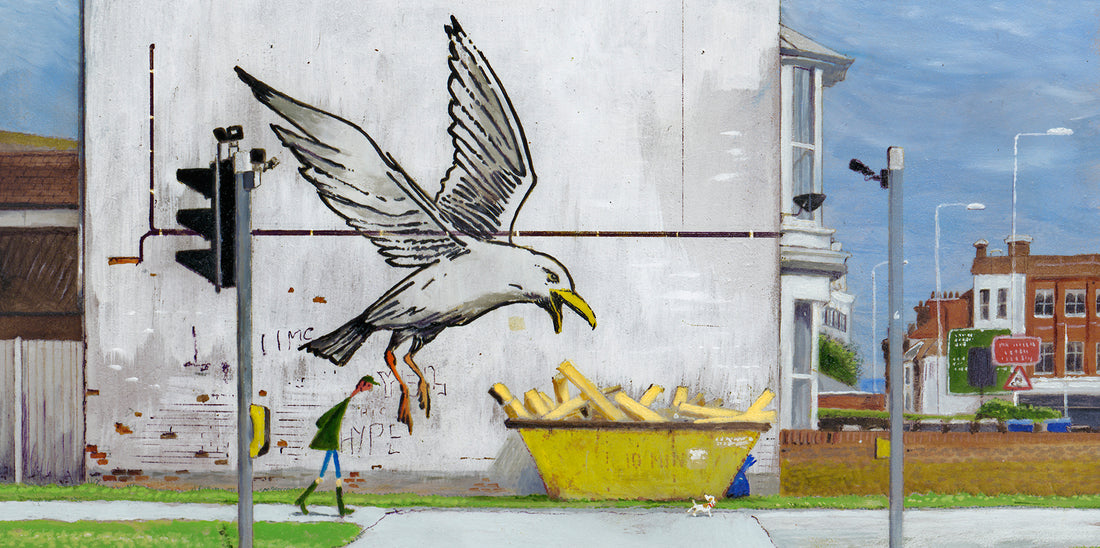One morning in the late 90s, the town of Stokes Croft, Bristol awoke to a large wall mural depicting a teddy bear branding a molotov cocktail aimed at three armed policemen. The scene, which was painted across the wall of a solicitor’s office, is said to allude to the illegal raves that were becoming increasingly popular in the area. It is also thought that the specific trigger for this painting came from the Winterstoke Road riot; an event whereby police officers attacked unarmed partygoers. It was titled Mild Mild West (alluding to Bristol being in the west country) with the alias ‘Banksy’ signed below.
This bold and timely piece of work made a political statement that its residents were more than happy to accommodate and has since become a paradigmatic piece of culture for Bristolians and British alike. Since then, Bansky’s repository grew with world renowned pieces like Balloon Girl, Kissing Coppers, and Bomb Hugger.
It is undeniable that Banksy is one of the most infamous artists of our time, but just what is it about their work that has caused such a stir, and why are we just as determined as ever to reveal the identity of this virtuoso?
From the 1950s to the 70s, the UK saw a wide range of art movements including Pop Art (featuring famous artists like Andy Warhol) and Minimalism, which urged viewers to focus solely on the art they see in front of them without being influenced by external emotional or geopolitical factors. It also gave a sense of anonymity, which could arguably be a format that Banksy took great inspiration from.
In the 1970s we entered what is known as the ‘Contemporary Art’ movement, which includes anything from Postmodernism with its immersive art installations and multimedia format, to Neo-Expressionism (such as the work of the German choreographer and performer Pina Baush). Moreover, the UK began to see street art and graffiti become a more commonplace contemporary aesthetic.
Contemporary Art does not concern itself purely on aesthetics or creating a pastiche of previous movements. More strikingly, it seeks to create a voice from the activist’s perspective. For example, women’s rights, as shown in feminist art like Marilyn Minter and Jenny Holzer.
With street art, there is an increasing sense of unrest that focuses on social disparities and political injustice.
It comes as no surprise, therefore, that Banksy would come into prominence at the time that they did. It is fair to say that the political landscape in the UK during the 90s was quite mundane compared to the era of Thatcherism with its Neoliberalist values; a time that likely affected Banksy as both an artist and, from what we have seen in their work, someone with anti-establishment values.
In the over 30 years that Bansky was first discovered, they have remained completely anonymous. Going back to the Minimalist art movement, anonymity held a great sense of power and autonomy whereby art could create a space for society to voice their values without fear of judgement. An individual openly disowning the political status quo is far more dangerous than an individual expressing an interest in an artist’s work.
Anonymity also gives an artist room to push the boundaries of what would otherwise be deemed unacceptable by society. In 2018, Banksy’s work Love is in the Bin went for sale at auction in Sotheby’s for £1,042,000. As soon as the sale was confirmed, the canvas began to slide to the bottom of the frame and begin shredding itself until it was halfway complete (Banksy claims to have intended for it to shred the entire canvas).
This would seem like another powerful political statement around austerity and the nature of commodifying creativity, however, the half-shredded painting later sold for £18,582,000 - almost three times the guide price it was expecting.
Could this political statement have actually been a calculated move in gaining untold wealth? Is Banksy a modern-day Robin Hood who is going to donate the money to the poor? As they remain anonymous, we will likely never know.
We also have no sense of Banksy’s background compared to their contemporaries. Damien Hirst had his first showcase at the Saatchi Gallery in the early 90s and had been a rebel who rejected authority from an early age and whose work often revolved around death. Tracey Emin is a biographical artist whose work centres on the abuse and sexual assault they experienced from childhood. They are 'artists with context', with a story that others can reach out and relate to.
It seems that Banksy’s values are at odds with one another; on one side we have artwork that consistently highlights anarchistic, liberal values, and on the other side we have an artist who has arguably earned more money than any of their British counterparts. We are living in a digital age where being anonymous is linked with online bullying, hate speech, and right-wing ideology. Could it be that the benefits of being an unnamed artist be outweighed by the cons of having your work and values being misconstrued?
Banksy’s art is an apt representation of our nameless society, and the values that we uphold. Their anonymity arguably serves as a mirror for the audience to look into and either embrace or reject; an image that would otherwise be muddied by the artist’s interpretation and backstory if they were to provide one.
Perhaps art doesn’t always need to pertain to what the artist’s inspiration was, but about the visceral effect it has on the humanity and our incessant need for answers and granularity.
If you're a Banksy fan, you'll be pleased to hear that Collier & Dobson published artist Chris Ross Williamson has created a series of witty wall art in homage to the infamous street artist. Head over to browse and buy from his collection including Gorlestone Banksy, Banksy's Rat, The Banksy and A Wingful of Fries.








